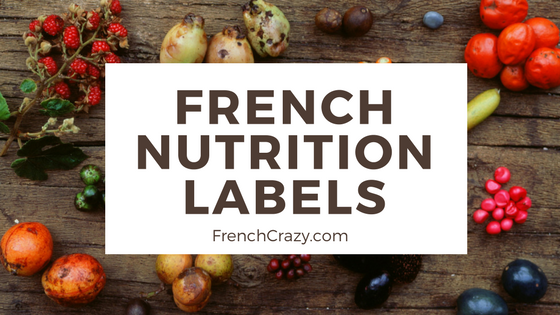
[ad_1]
So, you journey to France and also you needed to have a chunk of chocolate… Mmmm Esprit Noir à la Menthe! You are taking a gander at “Les Informations Nutritionnelles.”
No shock, it’s in French. What does 2190KJ pour 100g even imply?
Right this moment we’ll focus on the vocabulary related to meals packaging, diet, and fundamental components in French. Then I’ll clarify the right way to spot allergic info and the way the French portion their meals.

Widespread French Vitamin Vocabulary
These are phrases that you simply’ll see on most diet labels on French meals and I’ve translated what they imply to English:
Valeur énergétique: Energy (energetic worth)
Protéines: Protein
Lipides: Fat
Lipides dont acids gras saturés: Saturated Fat
Glucides: Carbohydrates
Glucides dont sucre: Sugar
Fibres allimentaire: Dietary Fiber
Sodium: Salt
Poids Internet: Whole Weight
Un Portion: A serving
Contient: Comprises
Conserver: Retailer (for instance, it’ll say “retailer” at a sure temperature to keep away from spoilage)
RNJ = Repères Nutritionnels Journaliers: Really helpful Each day Allowance
Widespread French Substances
Arôme: Flavoring (arôme pomme/cannelle would imply cinnamon-apple flavoring)
Avoine: Oats
Bicarbonate de soude: Baking soda
Blé (complète): Wheat (entire wheat)
Beurre (pâtissier): Butter (concentrated)
Colorant: Synthetic coloring
Eau: Water
Farine (de blé complète): Flour (entire wheat flour)
Huile (d’olive, tournesol, végétale): Oil (olive oil, sunflower oil, vegetable oil)
Lait (en poudre, écrémé): Milk (powdered milk, skimmed-milk)
Matière grasse (végétale): Fats, Lard (Vegetable fats)
Noix: Nuts (keep away from when you’ve got a nut allergy)
Oeuf: Egg
Sel: Salt
Sirop de glucose: Glucose syrup (corn syrup)
Vinaigre (balsamique, de vin rouge): Vinegar (balsamic…, pink wine…)
Fortunately some phrases resemble their English counterparts.
Now, once I learn the label of the chocolate, it says that 1 portion (10g) accommodates 220kJ (55kcal). In the event you paid consideration throughout chemistry or physics, you’ll understand that roughly 4.4 kilojoules is equal to 1 kilocalorie. One kcal is the same as 1 Calorie. Thus, 55kcals is the same as 55 Energy!
Not unhealthy for a sinful piece of chocolate.
Normally the French packaging will embody the dietary info for one serving and for the whole packet. So whenever you discover that consuming your morning cereal will add 1,995kcals to your stomach, you’re most likely wanting on the incorrect aspect.
Studying French diet labels could be annoying should you’re unfamiliar with the metric system. A simple option to estimate what makes a portion is to take the Poids Internet, or complete weight, after which divide that by the indicated portion dimension. So, if a field of cereal says a portion is 45 grams and the entire field accommodates 500 grams, then you definately would have roughly 11 parts. You possibly can eye out one-eleventh of the container and revel in your French meals accordingly. You would additionally weigh your cereal on a scale should you’re obsessing about this type of stuff.
Allergic reactions!?
I simply have a bit of apart for allergic individuals. An announcement that identifies allergic reactions would go one thing like this: Ce produit contient de la poudre de lait et est fabriqué sur une ligne de manufacturing utilisant différents varieties de noix. That lengthy, daunting French sentence is actually saying that the product accommodates powdered milk, and is made in a manufacturing facility that makes use of various kinds of nut merchandise. Studying these sentences grow to be crucial if you’re allergic to something. Clearly, you’ll keep away from this product when you’ve got any type of nut allergy.
Conclusion
I hope this information on the right way to learn French diet labels was useful. Please remark under should you want something, or need to add extra vocabulary to my checklist above. (P.S, have you ever ever puzzled how the French may at all times eat these things and never get fats? Try my article: The French Paradox).
[ad_2]